Today, homeowners, landscapers, and urban planners alike face a dizzying array of choices when it comes to paving materials, designs, and installation methods. Each option comes with its own set of advantages, challenges, and long-term implications for maintenance and sustainability.
Whether you’re considering a small backyard project or planning large-scale urban development, understanding the fundamentals of paving is crucial.
This comprehensive guide aims to navigate you through the complex world of paving, shedding light on traditional practices, cutting-edge innovations, and everything in between. By exploring the intricate details of paving, we hope to equip you with the knowledge needed to make informed decisions for your next project.
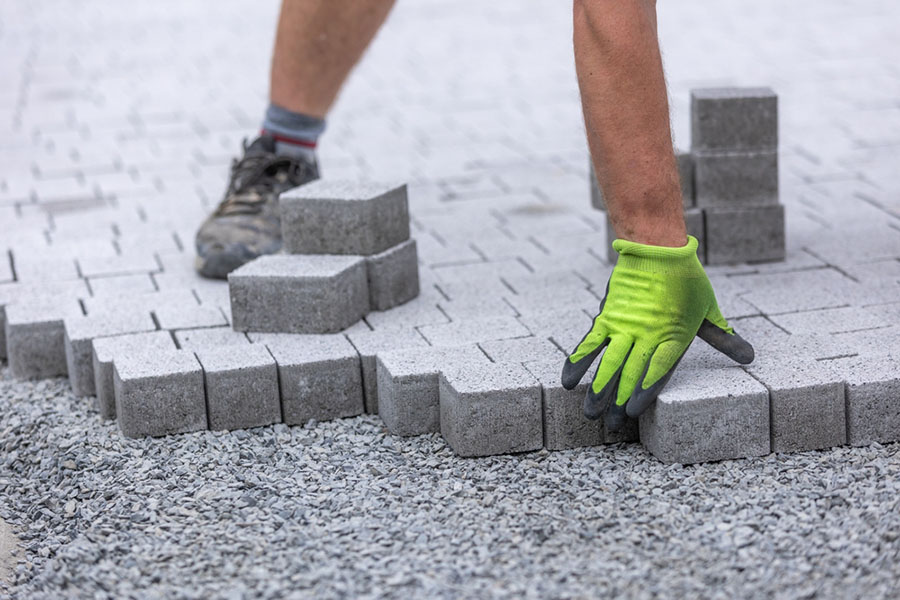
Types of Paving Materials
Asphalt
Asphalt is a durable and flexible paving material made from aggregate and bitumen. It’s widely used for roads and driveways due to its quick installation process and ability to withstand heavy loads. Regular maintenance, such as sealing, can extend its lifespan to 20-30 years.
Concrete
Known for its strength and longevity, concrete offers various paving options including plain, stamped, and exposed aggregate. It can last 30-40 years or more with proper installation. Concrete provides extensive customization possibilities, allowing for coloring and pattern additions to match any aesthetic preference.
Pavers
Available in brick, stone, and concrete varieties, pavers offer excellent aesthetic appeal and design flexibility. While installation can be labor-intensive, they’re easy to repair by replacing individual units. Proper installation includes creating a stable base and securing it with edge restraints.
Gravel
Gravel is a cost-effective paving option that comes in various types such as pea gravel, crushed stone, and river rock. It offers excellent drainage properties, making it environmentally friendly for areas prone to water accumulation. Installation and maintenance costs are generally lower compared to other paving materials.
Permeable paving
Permeable paving helps manage stormwater runoff by allowing water to seep through to the ground below. It can be made from permeable concrete, asphalt, or interlocking pavers. While it offers environmental benefits, it requires specific maintenance, like regular cleaning, to prevent the porous surface from clogging.
Choosing the Right Paving Material
Assessing your needs
Selecting the appropriate paving material begins with a thorough assessment of your specific requirements. Consider the intended use of the area. Driveways need materials that can withstand vehicle weight, while patios require comfortable surfaces for foot traffic.
Your local climate plays a significant role; freeze-thaw cycles can damage certain materials, while hot climates may cause some to soften or expand. Rainfall amounts should be considered for proper drainage needs.
Budget is another key factor, encompassing both initial installation costs and long-term expenses. Some cheaper options may require more frequent replacement, while more expensive materials might offer better value over time due to their longevity.
Material longevity and maintenance
Different paving materials have varying lifespans and maintenance requirements. Concrete and pavers can last several decades with proper care, while asphalt typically lasts 20-30 years. Gravel may need frequent replenishment but can last indefinitely.
Maintenance needs also differ. Concrete may need sealing every few years, asphalt requires periodic resealing and crack filling, and pavements might need occasional re-sanding of joints.
Consider the ease of repair for each material. Individual pavers can be easily replaced, concrete repairs can be noticeable, asphalt can be patched relatively easily, and gravel is simple to add or replace as needed.
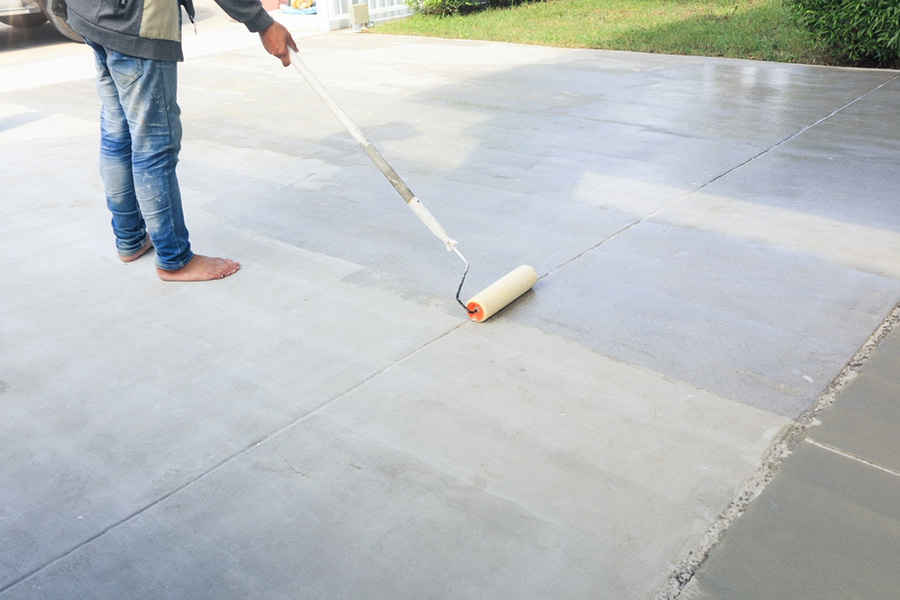
Aesthetics and design considerations
The visual appeal of your paving choice also needs to be considered. Different materials offer various aesthetic options – concrete can be colored and stamped with patterns, pavers come in many shapes, sizes, and colors, while asphalt is typically limited to black or dark gray.
Choose a material that complements your property’s style; traditional homes might suit brick pavers or stamped concrete, while modern designs might prefer sleek, uniform surfaces. Some materials offer more design flexibility than others.
Also, consider the environmental impact of your choice, as permeable materials can help with water management. Lastly, think about how your paving choice might affect your property’s resale value. High-quality materials can boost curb appeal, while unique or high-maintenance choices might limit buyer interest as they may not appeal to everyone.
Process of Paving Installation
Initial consultation and site assessment
The paving installation process begins with an initial consultation and site assessment. This crucial first step involves meeting with a paving contractor to discuss your needs and vision for the project. It’s an opportunity to ask questions about their experience and process, ensuring you’re comfortable with their expertise.
During this phase, the contractor will conduct a thorough evaluation of your property. They’ll examine soil conditions, assess drainage issues, and take into account any existing structures or landscaping that might impact the project. This comprehensive assessment forms the foundation for the entire paving process.
Based on this evaluation, the contractor will create a preliminary design and provide a cost estimate. This estimate typically includes materials, labor, and potential additional costs that might arise during the project. It’s important to review this estimate carefully and ask for clarification on any points that seem unclear.
Choosing the right materials
Material selection process
Once the initial assessment is complete, the next step is selecting the appropriate paving materials. This decision is critical as it affects not only the appearance of your paved area but also its durability, maintenance requirements, and overall cost. Your contractor should present you with various options, explaining the pros and cons of each.
Key considerations
Consider factors such as the material’s lifespan, how well it withstands your local climate, and how much maintenance it requires. It’s often helpful to see samples of the materials or even visit completed projects to get a better sense of how they look in real-world applications.
Visualization tools
Some contractors may offer virtual demonstrations to help you visualize the final result. Take your time with this decision, as the right choice will ensure your satisfaction with the project for years to come.
Remember to consider long-term value rather than just initial cost. Also, ensure that your chosen material complies with any local regulations or homeowner association rules.
Site preparation and grading
With materials selected, the actual work on your property begins with site preparation and grading. This phase is critical for ensuring the longevity and performance of your paved surface. The first step is clearing the area of any vegetation, debris, or existing paving. This provides a clean slate for the new installation.
Next, the soil is tested for stability and drainage capabilities. Depending on the results, the soil may need to be treated or even replaced to provide a solid foundation for the paving. Proper grading is then carried out to create the necessary slopes for effective water drainage. This step is pivotal in preventing water pooling, which can lead to damage and shortened lifespan of the paving.
The preparation phase may take several days, depending on the size of the area and the amount of work required to achieve the ideal foundation.
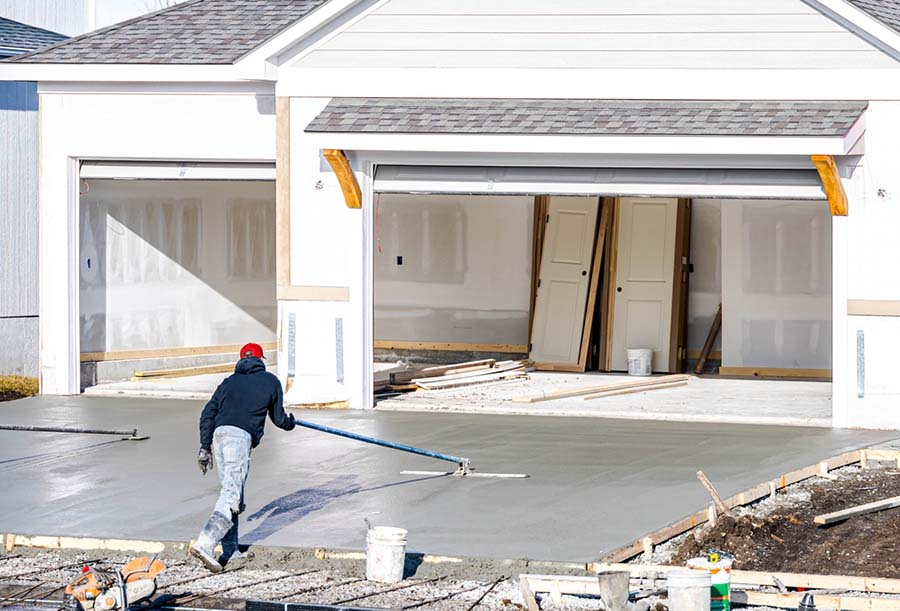
Installing the paving material
Once the site is properly prepared, the actual installation of the paving material begins. This process varies significantly depending on the chosen material. Generally, it starts with the installation of a base layer, usually made of crushed stone or gravel. This base provides stability and aids in drainage.
The chosen paving material is then installed on top of this base. For concrete, this involves pouring and smoothing the material. For pavers, each unit is laid individually in the desired pattern. Asphalt is typically spread and rolled. Regardless of the material, proper installation techniques are crucial for ensuring a durable and attractive result.
After installation, the material is compacted to remove air pockets and ensure stability. Depending on the material, there may be a settling period before the next steps can be taken.
Sealing and finishing touches
After the main installation is complete, the focus shifts to protecting and enhancing the new paved surface. Most paving materials require the application of a sealant. This protective layer helps guard against stains, weather damage, and in some cases, UV radiation.
The type of sealant used depends on the paving material and should be applied according to manufacturer specifications. Once the sealant is applied, any decorative elements can be added. This might include borders, patterns, or the installation of lighting or other features to enhance the area’s functionality and aesthetics.
The final step in this phase is allowing adequate time for curing. The duration varies depending on the materials used, and it’s important to follow the contractor’s advice on when the surface can be safely used. Proper curing ensures the longevity and performance of your new paved area.
Final inspection and walkthrough
Quality assurance check
The paving installation process concludes with a final inspection and walkthrough. Your contractor should perform a thorough quality check to ensure all aspects of the installation meet industry standards. This includes checking for proper drainage, the evenness of the surface, and the quality of any decorative elements. Any issues identified during this check should be addressed promptly.
Client walkthrough and project completion
Following the contractor’s inspection, you’ll have the opportunity to do a walkthrough yourself. This is your chance to examine the work closely and ask any final questions.
The contractor should explain maintenance requirements and provide tips for keeping your new paved area in top condition. If you’re satisfied with the work, you’ll sign off on the project.
Be sure to receive all relevant paperwork, including warranty information and care instructions. Understanding how to properly maintain your new paving will help ensure its beauty and functionality for years to come.
Choosing a Paving Contractor
Factors to consider
Licensing and certification
Check if the contractor has proper licensing, which ensures they meet local regulations. Look for industry certifications as well; these show commitment to quality and indicate ongoing education in the field.
Ask to see proof of both license and certifications. Be aware that licensing requirements vary by location. Research your area’s specific requirements to ensure full compliance.
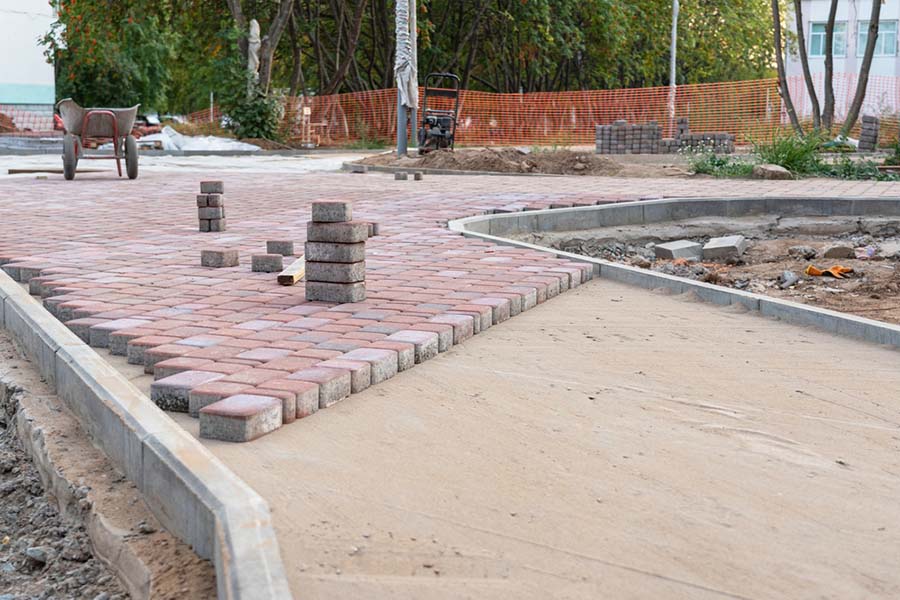
Experience and expertise
Consider how long the contractor has been in business; more experience often means better problem-solving skills and can indicate reliability. Look at the types of projects they’ve completed and ensure they have experience with your specific paving needs.
Ask for a portfolio of their work. Inquire about their specialties and any unique techniques they employ, as this can help you determine if they’re the best fit for your project.
Response time and availability
Evaluate the contractor’s response time to inquiries, as this indicates professionalism and potential responsiveness during the project. Discuss their current workload and availability, ensuring they can start and complete your project promptly.
Be cautious of contractors who seem overly eager or too busy. Inquire about their communication methods. Clear and regular updates help keep your project on track.
Reviews and testimonials
Read online reviews from past clients. Look for patterns in both positive and negative feedback. Pay attention to how the contractor responds to criticism. Ask for references from recent clients. Contact these references to ask about their experience.
Inquire about the quality of work and the contractor’s professionalism. Consider checking with local business bureaus or contractor associations. They may have additional information on the contractor’s reputation and history.
Insurance coverage
Verify that the contractor has liability insurance, which protects you if accidents occur on your property. Ask to see their insurance certificate. Check if they have worker’s compensation insurance, which covers their employees in case of injury. It also protects you from potential lawsuits.
Look for any additional insurance they carry, as some contractors have specialized coverage that may be relevant to your project.
Technology and equipment used
Inquire about the equipment the contractor uses. Modern, well-maintained equipment often leads to better results and can indicate a contractor’s investment in their business.
Ask about any technology they use in planning or execution. This might include design software or GPS-guided machinery. Advanced technology can improve precision and efficiency. Discuss how their technology and equipment choices benefit your specific project. This can help you understand the value they bring to the job.
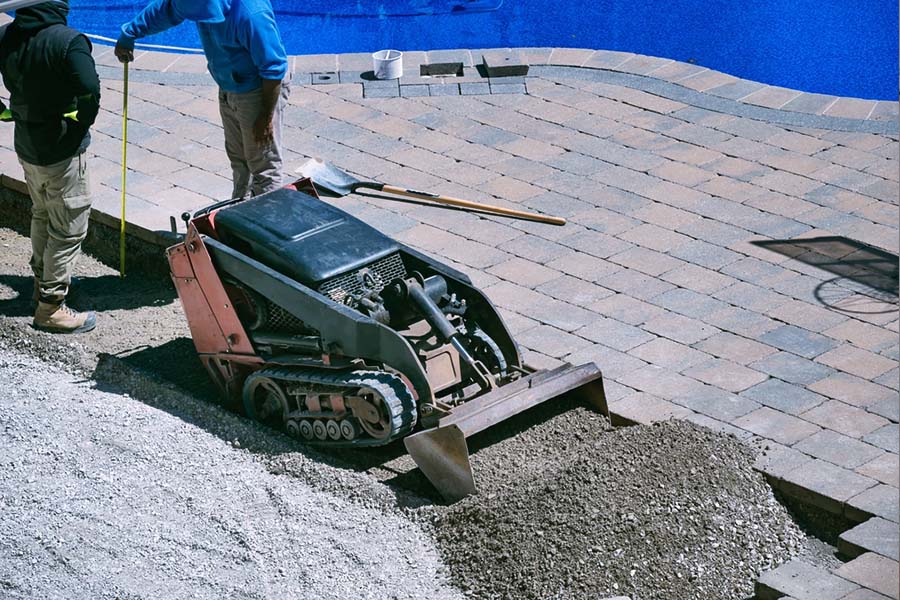
Questions to ask potential contractors
Project-specific questions
Ask how they would approach your specific project; this shows their problem-solving skills and helps you understand their process. Inquire about potential challenges they foresee, demonstrating their experience and foresight. Ask how they plan to address these challenges.
Timeline and scheduling
Request a detailed project timeline, including start and end dates and major milestones. Discuss how they handle unexpected delays, such as weather impacts. Understand their policies for rescheduling and communication.
Cost and payment
Request a detailed written estimate breaking down costs for materials and labor. Ask about potential additional costs. Discuss payment terms and schedules, understanding when payments are due. Be cautious of contractors requiring large upfront payments.
Warranty and follow-up
Ask about warranties on materials and workmanship; understand what’s covered and for how long. Get this information in writing. Inquire about their policy for addressing post-completion issues, who to contact if problems arise, and their process for handling complaints or concerns.
DIY vs. Professional Paving Installation
When considering paving installation, the choice between DIY and professional services depends on various factors. DIY might be feasible for small projects like short walkways or patios under 100 square feet, offering cost savings for those with basic skills.
However, professional installation brings expertise, quality, and efficiency to the table. Professionals have the right tools, experience to handle unexpected issues, and knowledge of proper techniques, often resulting in more durable and long-lasting results.
DIY efforts can face pitfalls such as lack of proper tools, inadequate site preparation, underestimated time and physical demands, and potential for costly mistakes.
While DIY can be rewarding for small projects, larger or more complex paving installations generally benefit from professional expertise to ensure the best long-term outcome.
Cost Considerations and Budgeting
Cost considerations and budgeting for home renovations involve several key aspects. Breaking down costs includes materials, labor, and permits. To stay within budget, prioritize essential elements, compare contractor quotes, and consider DIY options where appropriate.
Explore financing options like home improvement loans and look for government rebates or energy-efficient upgrade incentives. Plan for unexpected expenses by setting aside a contingency fund, typically 10-20% of the total budget.
Identify potential risks in advance and maintain a flexible timeline to manage unforeseen issues. By carefully considering these factors, homeowners can create a realistic budget. This minimizes financial stress and increases the likelihood of a successful renovation project. It adds value to their home without breaking the bank.
Maintaining Your Paving
Maintaining your paving involves regular upkeep and seasonal care. Key tasks include routine cleaning, weed control, and periodic sealing. Seasonal checklists help address specific needs. These include spring cleaning and frost damage repair, summer expansion monitoring, fall leaf removal and crack filling, and winter snow management.
Watch for signs that indicate professional help is needed, such as large cracks, drainage issues, or stubborn discoloration. Regular sweeping prevents debris buildup, while proper weed control protects paving integrity. Sealing every 3-5 years guards against stains and weather damage.
Be cautious with de-icing products in winter, opting for sand or gravel when possible. By following these maintenance tips and addressing issues promptly, you can extend the life of your paving and keep it looking great year-round.
Sustainable and Eco-Friendly Paving Options
Types of eco-friendly paving materials
Sustainable and eco-friendly paving options offer numerous benefits for the environment and urban spaces. Permeable materials like porous asphalt, pervious concrete, and interlocking pavers allow water to seep into the ground, reducing runoff and recharging groundwater.
Eco-friendly solutions include recycled materials, natural stone, and grass pavers, which minimize waste and blend with natural surroundings.
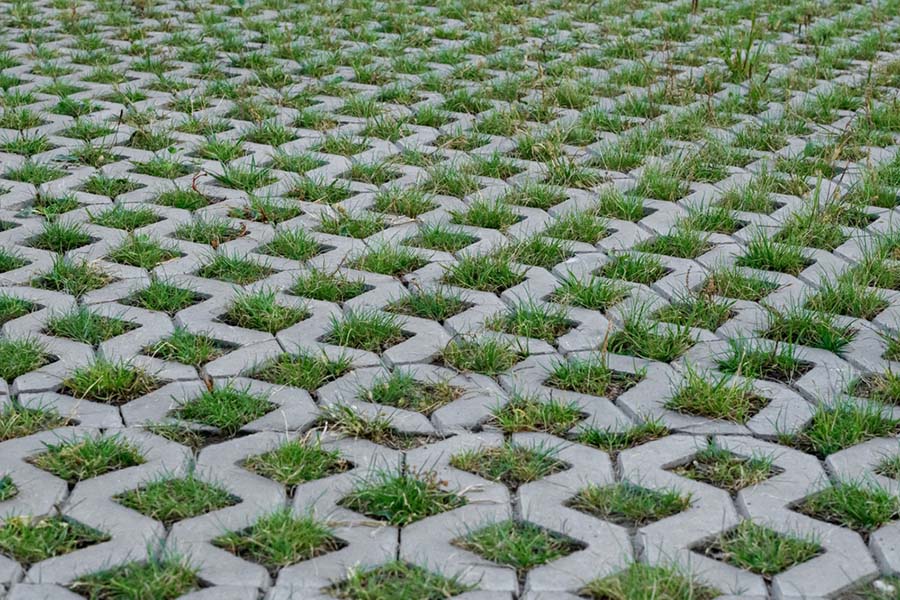
Environmental benefits of green paving
These green options provide excellent water management, helping to prevent flooding and filter pollutants. They also aid in temperature regulation, reducing the urban heat island effect and creating more comfortable outdoor areas.
Additionally, sustainable paving often has a longer lifespan and lower environmental impact, using fewer resources and sometimes even improving air quality.
By choosing these options, property owners can contribute to better stormwater management, energy efficiency, and overall environmental sustainability in urban and suburban settings.
Common Challenges in Paving Installation
Unexpected issues
Common challenges in paving installation include dealing with unexpected issues, ensuring proper installation methods, and managing project timelines. Unexpected problems often arise from soil conditions, drainage complications, and weather-related setbacks.
Additionally, unforeseen utility conflicts and hidden structural issues beneath the surface can cause significant delays and cost overruns. These challenges require the installation team’s quick problem-solving skills and adaptability.
Proper installation techniques
Proper installation requires correct base preparation, appropriate material handling, and accurate leveling and grading. Key strategies include conducting soil tests, addressing drainage issues early, and maintaining flexibility. Proper base compaction, adherence to material handling guidelines, and precise leveling are crucial for long-lasting results.
Attention to detail in joint spacing and proper sealing techniques are essential for preventing future issues such as weed growth and water infiltration. Regular quality checks throughout the installation process help ensure consistency and adherence to project specifications.
Timeline management
Managing timelines involves planning for potential delays, coordinating with suppliers and subcontractors, and adapting to unforeseen circumstances. Building buffer time into schedules and regular communication with all parties involved helps keep projects on track.
By anticipating these challenges and implementing appropriate solutions, paving professionals can ensure successful installations and satisfied clients.
Trends in Paving Design
- Technological innovations – Recent trends in paving design showcase exciting innovations and smart home integrations. Self-healing pavements, solar-powered surfaces, and interactive illuminated paving are at the forefront of technology.
- Smart home integration – Smart home integration brings sensor-embedded pavements that can trigger lighting or security systems. It also enables automated maintenance alerts and introduces climate-responsive features that adapt to weather conditions.
- Materials and finishes – Popular materials and finishes include textured and stamped concrete, eco-friendly composites, and eye-catching metallic or iridescent surfaces.
These trends focus on enhancing functionality, sustainability, and aesthetics. From generating electricity to reducing maintenance costs and improving safety, modern paving solutions offer multiple benefits.
As technology advances, we can expect even more integration between paving and smart home systems, creating more efficient, sustainable, and visually appealing outdoor spaces for both residential and commercial properties.

Frequently Asked Questions
How long does a typical paving installation take?
The duration of a paving installation can vary depending on the size of the area and the type of material used. For a standard residential driveway, the process usually takes 2-5 days. Larger commercial projects may take several weeks to complete.
Factors that can affect the timeline include weather conditions, site preparation requirements, and the complexity of the design. It’s important to discuss the expected timeline with your contractor and allow for some flexibility in case of unforeseen circumstances.
What’s the difference between asphalt and concrete paving?
Asphalt and concrete are both popular paving materials, but they differ in several ways. Asphalt is typically less expensive and faster to install, but may require more frequent maintenance. Concrete is more durable and offers more design options, but it’s generally more expensive and takes longer to cure.
Climate can also play a role in choosing between asphalt and concrete. Asphalt tends to perform better in colder climates as it’s less prone to damage from freeze-thaw cycles, while concrete can be a better choice in hotter climates due to its heat-reflecting properties.
How often should I seal my paved surface?
The frequency of sealing depends on the type of paving material and usage. For asphalt driveways, it’s recommended to seal every 2-3 years. Concrete pavements typically need sealing every 4-5 years. However, areas with heavy traffic or exposure to harsh weather conditions may require more frequent sealing.
Regular inspections can help determine if sealing is needed sooner. Look for signs such as fading color, surface cracks, or water absorption. Proper sealing not only enhances the appearance of your pavement but also extends its lifespan by protecting it from water damage, UV rays, and chemical spills.
Is it true that you can’t pave during winter months?
This is a common misconception. While extreme cold can affect paving, modern techniques and materials allow for installation in cooler temperatures. Asphalt can be laid in temperatures as low as 40°F (4°C), and there are cold-weather mixes available.
Concrete can also be poured in winter with proper precautions. However, paving in winter requires extra care. Contractors may use heated enclosures, chemical accelerators, or hot water for mixing to ensure proper curing. It’s important to work with experienced professionals who understand how to adapt their methods to colder conditions.
Do darker paving materials always get hotter than lighter ones?
While it’s generally true that darker surfaces absorb more heat, this doesn’t always translate to significantly hotter pavement. Modern paving materials are designed with heat absorption in mind. Some dark-colored asphalt mixes include reflective materials that can reduce heat absorption.
Also, factors like material density, underlying base materials, and surrounding landscaping can influence pavement temperature more than color alone. Proper design and installation techniques can help mitigate heat retention regardless of the paving color chosen.
Locations
California
- Los Angeles
- San Diego
- San Jose
- San Francisco
- Fresno
- Sacramento
- Long Beach
- Oakland
- Bakersfield
- Anaheim
- Santa Ana
- Riverside
- Stockton
- Chula Vista
- Irvine
- Fremont
- San Bernardino
- Modesto
- Fontana
- Oxnard
- Moreno Valley
- Glendale
- Huntington Beach
- Santa Clarita
- Oceanside
- Garden Grove
- Rancho Cucamonga
- Santa Rosa
- Ontario
- Elk Grove
- Corona
- Lancaster
- Palmdale
- Hayward
- Salinas
- Pomona
- Sunnyvale
- Escondido
- Torrance
- Pasadena
- Fullerton
- Orange
- Roseville
- Visalia
- Thousand Oaks
- Concord
- Simi Valley
- Santa Clara
- Victorville
- Vallejo
- Berkeley
- El Monte
- Downey
- Costa Mesa
- Inglewood
- Carlsbad
- Fairfield
- Ventura
- Temecula
- Antioch
- Richmond
- West Covina
- Murrieta
- Norwalk
- Daly City
- Burbank
- Santa Maria
- El Cajon
- San Mateo
- Rialto
- Clovis
- Jurupa Valley
- Compton
- Vista
- Mission Viejo
- South Gate
- Vacaville
- Carson
- Hesperia
- Santa Monica
- Westminster
- Redding
- Santa Barbara
- Chico
- Newport Beach
- San Leandro
- Indio
- Tracy
- Livermore
- Baldwin Park
- Merced
- Chino
- Redwood City
- Lake Forest
- Napa
- Tustin
- Buena Park
- Mountain View
- Lakewood
- San Marcos
Texas
- Houston
- San Antonio
- Dallas
- Austin
- Fort Worth
- El Paso
- Arlington
- Corpus Christi
- Plano
- Laredo
- Lubbock
- Garland
- Irving
- Amarillo
- Grand Prairie
- Brownsville
- McKinney
- Frisco
- Pasadena
- Mesquite
- Killeen
- Carrollton
- Midland
- Waco
- Denton
- Abilene
- Odessa
- Beaumont
- Round Rock
- Richardson
- Pearland
- College Station
- Tyler
- League City
- Wichita Falls
- Allen
- San Angelo
- Edinburg
- Sugar Land
- Mission
- Conroe
- Bryan
- New Braunfels
- Pharr
Florida
- Jacksonville
- Miami
- Tampa
- Orlando
- St. Petersburg
- Hialeah
- Tallahassee
- Port St. Lucie
- Cape Coral
- Fort Lauderdale
- Pembroke Pines
- Hollywood
- Miramar
- Gainesville
- Coral Springs
- Clearwater
- Miami Gardens
- Palm Bay
- Pompano Beach
- West Palm Beach
- Lakeland
- Davie
- Miami Beach
- Plantation
- Sunrise
- Boca Raton
- Deltona
- Palm Coast
- Largo
- Melbourne
New York
- New York City
- Buffalo
- Rochester
- Yonkers
- Syracuse
- Albany
- New Rochelle
- Mount Vernon
- Schenectady
- Utica
- White Plains
- Hempstead
- Troy
- Niagara Falls
- Binghamton
- Freeport
- Valley Stream
- Long Beach
- Rome
- North Tonawanda
Pennsylvania
- Philadelphia
- Pittsburgh
- Allentown
- Erie
- Reading
- Scranton
- Bethlehem
- Lancaster
- Harrisburg
- Altoona
Illionois
- Chicago
- Aurora
- Rockford
- Joliet
- Naperville
- Springfield
- Peoria
- Elgin
- Waukegan
- Champaign
- Bloomington
- Decatur
- Evanston
- Des Plaines
- Berwyn
- Wheaton
- Belleville
Ohio
- Columbus
- Cleveland
- Cincinnati
- Toledo
- Akron
- Dayton
Georgia
- Atlanta
- Augusta
- Columbus
- Savannah
- Athens
North Carolina
- Charlotte
- Raleigh
- Greensboro
- Durham
- Winston-Salem
- Fayetteville
- Cary
- Wilmington
- High Point
Michigan
- Detroit
- Grand Rapids
- Warren
- Sterling Heights
- Ann Arbor
- Lansing
- Flint
- Dearborn
- Livonia
- Troy
New Jersey
- Newark
- Jersey City
- Paterson
- Elizabeth
- Edison
- Woodbridge
- Lakewood
- Toms River
- Hamilton
- Trenton
Virginia
- Virginia Beach
- Norfolk
- Chesapeake
- Richmond
- Newport News
- Alexandria
- Hampton
- Roanoke
- Portsmouth
- Suffolk
Washington
- Seattle
- Spokane
- Tacoma
- Vancouver
- Bellevue
- Kent
- Everett
- Renton
- Federal Way
- Yakima
Massachusetts
- Boston
- Worcester
- Springfield
- Lowell
- Cambridge
- New Bedford
- Brockton
- Quincy
- Lynn
- Fall River
Arizona
- Phoenix
- Tucson
- Mesa
- Chandler
- Glendale
- Scottsdale
- Gilbert
- Tempe
- Peoria
- Surprise
Tennessee
- Nashville
- Memphis
- Knoxville
- Chattanooga
- Clarksville
- Murfreesboro
- Franklin
- Jackson
- Johnson City
- Bartlett
Indiana
- Indianapolis
- Fort Wayne
- Evansville
- South Bend
- Carmel
- Fishers
- Bloomington
- Hammond
- Gary
- Lafayette
Missouri
- Kansas City
- St. Louis
- Springfield
- Columbia
- Independence
- Lee’s Summit
- O’Fallon
- St. Joseph
- St. Charles
- St. Peters
Maryland
- Baltimore
- Columbia
- Germantown
- Silver Spring
- Waldorf
- Glen Burnie
- Ellicott City
- Frederick
- Dundalk
- Rockville
Wisconsin
- Milwaukee
- Madison
- Green Bay
- Kenosha
- Racine
- Appleton
- Waukesha
- Oshkosh
- Eau Claire
- Janesville
Colorado
- Denver
- Colorado Springs
- Aurora
- Fort Collins
- Lakewood
- Thornton
- Arvada
- Westminster
- Pueblo
- Centennial
Minnesota
- Minneapolis
- St. Paul
- Rochester
- Duluth
- Bloomington
- Brooklyn Park
- Plymouth
- St. Cloud
- Eagan
- Woodbury
South Carolina
- Columbia
- Charleston
- North Charleston
- Mount Pleasant
- Rock Hill
- Greenville
- Summerville
- Sumter
- Goose Creek
- Hilton Head Island
Alabama
- Birmingham
- Montgomery
- Mobile
- Huntsville
- Tuscaloosa
Louisiana
- New Orleans
- Baton Rouge
- Shreveport
- Lafayette
- Lake Charles
Kentucky
- Louisville
- Lexington
- Bowling Green
- Owensboro
- Covington
Oregon
- Portland
- Salem
- Eugene
- Gresham
- Hillsboro
Oklahoma
- Oklahoma City
- Tulsa
- Norman
- Broken Arrow
- Edmond
Connecticut
- Bridgeport
- New Haven
- Stamford
- Hartford
- Waterbury
Iowa
- Des Moines
- Cedar Rapids
- Davenport
- Sioux City
- Iowa City
Mississippi
- Jackson
- Gulfport
- Southaven
- Hattiesburg
- Biloxi
Arkansas
- Little Rock
- Fort Smith
- Fayetteville
- Springdale
- Jonesboro
Utah
- Salt Lake City
- West Valley City
- Provo
- West Jordan
- Orem
Nevada
- Las Vegas
- Henderson
- Reno
- North Las Vegas
- Sparks
Kansas
- Wichita
- Overland Park
- Kansas City
- Olathe
- Topeka
New Mexico
- Albuquerque
- Las Cruces
- Rio Rancho
- Santa Fe
- Roswell
Nebraska
- Omaha
- Lincoln
- Bellevue
- Grand Island
- Kearney
West Virginia
- Charleston
- Huntington
- Parkersburg
- Morgantown
- Wheeling
Idaho
- Boise
- Meridian
- Nampa
- Idaho Falls
- Pocatello
Hawaii
- Honolulu
- Pearl City
- Hilo
- Kailua
- Waipahu
Maine
- Portland
- Lewiston
- Bangor
- South Portland
- Auburn
New Hampshire
- Manchester
- Nashua
- Concord
- Derry
- Dover
Rhode Island
- Providence
- Warwick
- Cranston
- Pawtucket
- East Providence
Montana
- Billings
- Missoula
- Great Falls
- Bozeman
- Butte
Delaware
- Wilmington
- Dover
- Newark
- Middletown
- Smyrna
South Dakota
- Sioux Falls
- Rapid City
- Aberdeen
- Brookings
- Watertown
North Dakota
- Fargo
- Bismarck
- Grand Forks
- Minot
- West Fargo
Alaska
- Anchorage
- Fairbanks
Vermont
- Burlington
- South Burlington
Wyoming
- Cheyenne
- Casper
